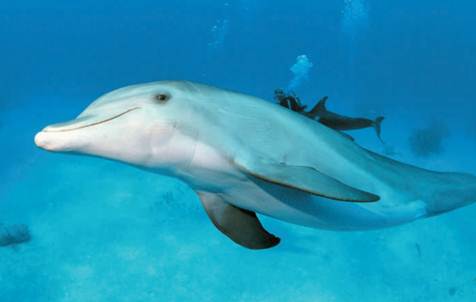


 النبات
النبات
 الحيوان
الحيوان
 الأحياء المجهرية
الأحياء المجهرية
 علم الأمراض
علم الأمراض
 التقانة الإحيائية
التقانة الإحيائية
 التقنية الحيوية المكروبية
التقنية الحيوية المكروبية
 التقنية الحياتية النانوية
التقنية الحياتية النانوية
 علم الأجنة
علم الأجنة
 الأحياء الجزيئي
الأحياء الجزيئي
 علم وظائف الأعضاء
علم وظائف الأعضاء
 الغدد
الغدد
 المضادات الحيوية
المضادات الحيوية|
Read More
Date: 20-10-2015
Date: 18-10-2015
Date: 9-10-2015
|
Ocean Ecosystems: Open Ocean
The realm of open water, called the pelagic zone, has the greatest volume and vertical range of any life zone. It includes the region above the continental shelf, called the neritic province, and the region beyond, called the oceanic province. Gradations in light, temperature, water chemistry, nutrient content, and pressure result in a diversity of environments that are filled by a large number of species.
Life is found throughout the water column (that is, top to bottom), but mostly in the photic zone, the region where sunlight makes photosynthesis possible. Organisms are also more abundant where there are more nutrients: in the neritic, where nutrients wash off the land, and in upwelling zones, where relatively cold nutrient-rich waters from the deep ocean rise to the surface. Pelagic life is dominated by plankton, mostly tiny organisms that move with water currents. Photosynthesis by phytoplankton is directly or indirectly the primary food source for all marine life. The animals, or zooplankton, that eats them may also be tiny, like krill, or they may be larger, like jellyfish, and able to make small, directed motions.
The active swimmers that inhabit the open ocean are called nekton. While the vast majority of nekton is fish and mammals, they include invertebrates, such as mollusks and crustaceans. The most productive waters in the world are upwelling zones, such as those of the west coast of South America. Here, the abundance of nutrients supports a large population of phytoplankton, which in turn is the foundation of rich fishing grounds. If upwelling stops, as happens off Peru during an El Nino event, the fish population declines; if the fishery has already been weakened by overfishing, it may collapse, as did the Peruvian anchovy fishery in the early 1970s.
The ocean has a moderating effect on world climate because water has a high ability to absorb and store heat. When prevailing winds come off an ocean the climate is milder than in locations with no oceanic influence. This is why annual temperature fluctuations are much smaller in western than in eastern coastal North America. The surface layer of the ocean is a heat reservoir that may maintain temperature anomalies for years, and alter rainfall patterns. For example, increased sea surface temperature results in increased evaporation. This increases rainfall and therefore condensation, which provides the energy to drive an El Nino event.
The enormous productivity of phytoplankton has a large effect on the atmosphere, since these organisms use carbon dioxide (CO2) and release oxygen. Also, CO2 is highly soluble in seawater and the ocean is a carbon

A bottlenosed dolphin in the Bahamas. Gradations in light, temperature, water chemistry, nutrient content, and pressure result in a diversity of open ocean environments that are filled by a large number of species.
dioxide sink. Manipulations of oceanic chemistry have been proposed to control atmospheric levels of CO2, and possibly reduce greenhouse warming. In large regions of the ocean, phytoplankton growth is limited by lack of the trace element iron. In two experiments, small patches of the sea surface were fertilized with minute amounts of dissolved iron. This triggered a massive phytoplankton bloom: the phytoplankton growth rate doubled, its biomass increased by nearly thirty times, and its nitrate uptake increased by fourteen times. If phytoplankton populations were increased on a wide scale, phytoplankton might use more CO2. When these organisms died, some would fall to the seafloor, taking with them the carbon they had harvested from atmospheric CO2.
Referencesٌ
Carson, Rachel L. The Sea Around Us. New York: Oxford University Press, 1955.
Kunzig, Robert. The Restless Sea: Exploring the World Beneath the Waves. New York: W. W. Norton and Company, 1999.
Safina, Carl. Song for the Blue Ocean: Encounters Along the World’s Coasts and Beneath the Seas. Toronto, ON: Owl Books, 1999.



|
|
|
|
لشعر لامع وكثيف وصحي.. وصفة تكشف "سرا آسيويا" قديما
|
|
|
|
|
|
|
كيفية الحفاظ على فرامل السيارة لضمان الأمان المثالي
|
|
|
|
|
|
|
شعبة مدارس الكفيل: مخيَّم بنات العقيدة يعزِّز القيم الدينية وينمِّي مهارات اتخاذ القرار لدى المتطوِّعات
|
|
|